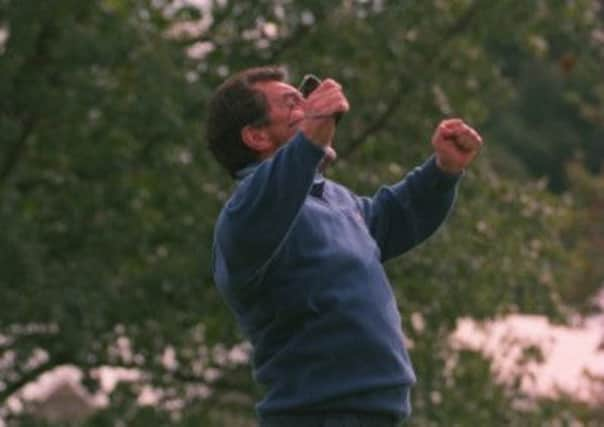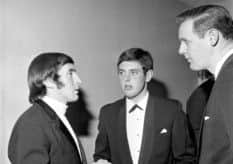John Huggan: In praise of classy Bernard Gallacher


The Appearance Money Cu…sorry Fed-Ex Cup is creeping towards its incomprehensible climax, one only a computer or mathematical genius can figure out. Just to be different, the lady professionals will today – wet weather permitting – complete their fifth (?) major of the year, the Evian Championship in France. The Women’s Home Internationals visited the much-underrated Scotscraig club in Fife. And, almost unnoticed, the currently all-but star-less European Tour has been stuttering along in the Netherlands.
The biggest and certainly most important headline, however, is that Bernard Gallacher continues to make an encouragingly steady recovery from his recent heart scare, having been allowed to leave the Aberdeen Royal Infirmary on Friday. The condition of the 64-year old Bathgate-native, something of a national treasure when you come to think about it, has no doubt been in every Scottish golfer’s mind over the last couple of weeks, but news of his illness provoked a closer look at the man and his life. Perhaps because of his inherent modesty, the four-time Scottish professional champion has never really been afforded the credit he is surely due for what has already been a quite remarkable career in golf.
Advertisement
Hide AdAdvertisement
Hide AdConsider this. Over the course of eight consecutive Ryder Cup appearances between 1969 and 1983, Gallacher went head-to-head with the likes of Lee Trevino, Jack Nicklaus and Lanny Wadkins – and beat them all. Indeed, he lost only one singles match when he wasn’t suffering from food poisoning (which laid him low during the 1973 encounter with the Americans at Muirfield). That was to eight-times major champion Tom Watson. Trevino, in fact, has more reason than most to curse the presence of the gritty Scot in first the Great Britain & Ireland, then European teams. In their six clashes – either foursomes, four-balls or singles – the six-times major champion, one of the game’s true geniuses, managed only one win.


At a time when overall defeat was routine, victory all but unheard of, Gallacher’s 50 per cent record in those eight Ryder Cups is more than impressive – 13 wins, 13 losses and five halved matches. And, in tow with compatriot Brian Barnes – the ultimate “little and large” combination – he managed five wins, four losses and a single half. Theirs was a formidable partnership indeed.
Barnes recalls: “Part of the reason why I dovetailed so well with Bernie was that he was a terrible driver of the ball. If I was going to hit the fairway nine times out of ten, he was going to miss it eight times out of ten.”
Barnes, who famously defeated Nicklaus twice in one day at the 1975 Ryder Cup, adds: “He will be first to admit it. He would always insist that I drove off the first tee. And, because we were invariably the first match off, I was the poor sod who had to go and hit the opening shot of the whole thing.
“But, because I was a powerful driver of the ball and could get us close to the green, it meant we could take advantage of the fact that Bernard had such a wonderful short game. And he was a great putter. We complemented each other, whether it was foursomes or fourballs. But you can only do that if you like the person you play with. Bernard and I always got on well together.”
That they did, although Gallacher’s memory of why they were paired together varies slightly from that of his old pal’s.
“We used to practise together back in the day and got on great,” he confirmed recently. “But, actually, I don’t think anyone else wanted to play with Brian! He was a very laid-back character and I think I knew how best to get the best out of him. His game certainly suited mine.”
The end of Gallacher’s Ryder Cup playing career was only the beginning of his ongoing involvement in the most exciting event in all of golf. Soon enough, the Scot was co-opted into backroom service as four-times skipper Tony Jacklin’s first assistant. And, in 1991, he took over for a three-match stint as non-playing captain, with the first of those, the notorious “War on the Shore” at Kiawah Island, proving to be the toughest of baptisms.
Advertisement
Hide AdAdvertisement
Hide Ad“A lot went on during the week,” he says, with only a hint of understatement.
“It was the time of Desert Storm and there was a lot of ‘patriotism’ flying about. The Americans seemed like they were on a mission. Still, I was surprised when Corey Pavin appeared on the first tee wearing his battle fatigue hat. I felt that was rude and unnecessary.
“Sadly, this was the first Ryder Cup I had ever been involved with as either a player or captain where the crowd was actually booing the visiting team.
“That happened when we walked on to greens. And there was cheering when one of us missed a putt. Which was very disappointing. It was more like an NFL match than a golf event.
“So 1991 was a turning point for the Ryder Cup. And not in a good way. Suddenly, there was hostility out there. And it was the first time the crowd actually participated in a match. The spectators affected the outcome of matches. I like to think we were gracious losers. Which is not to say that we enjoy losing, but we lost in the right way.”
Gallacher’s disappointment at the various shenanigans that went on at Kiawah Island is typical of the man. He played hard but he played fair, win or lose. Four years on, in fact, two incidents during and after the 1995 matches at Oak Hill aptly sum up the character of the man.
On the one hand, there is the enduring image of Europe’s non-playing skipper leaping high in the air as Irishman Philip Walton holed what proved to be the winning putt on the 18th green. And on the other, there is Gallacher, seeing his American counterpart, Lanny Wadkins, struggling to maintain his composure during the post-match speeches, walking across the podium to offer his old friend a helping hand and words of comfort. That is how golf and the Ryder Cup was meant to be, a fact spectators less than well-versed in the game’s etiquette would do well to remember at Gleneagles a year from now.
Gallacher’s career cannot be completely summed up by the Ryder Cup, of course. This is a man who combined playing the tour with the demanding job of head professional at Wentworth (where he, uniquely, was captain in 2000). There were the 13 wins on the European Tour and one more on the Senior Tour, as well as the 1968 rookie of the year award and the 1969 Vardon Trophy (awarded to the leading money-winner). And, more recently, he has been an occasional and insightful contributor to Radio Five Live’s on-course coverage of major events.
So the wee laddie from Bathgate has done well for himself and well for the game.
Now, if only Hibs could finally win the Scottish Cup (aye right).
Get well soon Bernard.